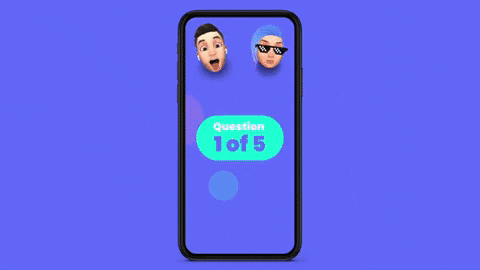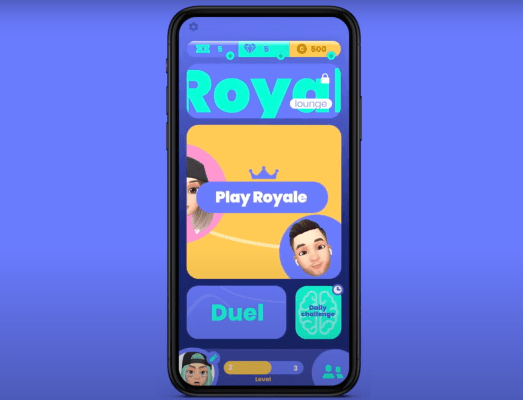In its first few weeks of release, the latest game from QuizUp founder Thor Fridriksson took the top spot in the Games Section of Apple’s App Store and was the top app (for a brief time) in the App Store at large.
Since its launch on June 17, Trivia Royale has been downloaded more than 2.5 million times, with day-one retention of 45% and week-one retention of 45% on iOS, according to the company. Average daily usage per user is around 30 minutes. It currently sits in the number six spot in the Free Games category on the App Store.
There is no shortage of mobile games, but in such a cluttered space, it’s difficult to break through the noise. So how did Trivia Royale do it?
The game, which lets users compete in a 1,000-person, single-elimination trivia tournament, is built on the Teatime Games platform. Teatime emphasizes the fun of playing against other humans in the mobile gaming landscape, giving users the ability to communicate via video chat while they play in a game on their smartphone.
The platform allows game developers to use this video chat functionality, which comes with Snapchat-like face filters or Apple Memoji-style avatars, on their own games. But for Teatime to truly succeed as a gaming platform, the company needed a hit game, Fridriksson said.
The serial entrepreneur told TechCrunch that he decided to take off his CEO hat and return to his product roots by focusing on a category that few people know as well as he does: trivia.
The Trivia Royale tournament combines the scale of Battle Royale with the durability of trivia — whether it’s Jeopardy, HQ Trivia, bar trivia or this, we can’t get enough of it — or lets users match against one other player in a single category of trivia.
I’ve played around on the game for a while now and can say that it’s very well done, from the design to the production value. But more important than the mechanics of the tournament or the typeface or even the content of the questions are the avatars, which let users express themselves through customization and their real-life facial expressions.
But none of that means anything if players don’t join the game. So how did Trivia Royale earn more than 2.5 million downloads (and climbing) in a matter of days?
A big bet on TikTok
Fridriksson told TechCrunch that he has to give a ton of credit to his kids (who are 15 and 11). His daughter told him about TikTok and gave him a list of her favorite stars, including Addison Rae and Dixie D’Amelio.
Virality was the end goal. With a budget of less than $500,000 — Teatime has raised upwards of $9 million total — Fridriksson decided to bet around 40% of that spend on TikTok influencers, including those listed above, with the remainder going toward traditional user acquisition strategies like mobile ad networks.
“By our estimates, we are seeing lower cost per user by a mile when using TikTok influencers, rather than doing traditional [user acquisition],” he said.
Importantly, according to the CEO and co-founder, the company didn’t give TikTok influencers any scripts to work with. Instead, they asked them to play the game and use the hashtag #TriviaRoyale (as well as the required ad disclosure hashtags). Now, Fridriksson says TikTok lists tens of thousands of Trivia Royale videos with 29 million views on the hashtag, according to TikTok.
About 15% of downloads came from users the company paid to acquire, and of that cohort, the vast majority came from TikTok, not other user acquisition channels. Of course, that figure may actually be an under reporting of the metrics, as users will often hear about a game in one place before searching for it in the App Store, which would be tracked as an organic download. Fridriksson added that it can be equally difficult to track invites from one user to their friends, as people rarely use the in-game invitation feature. He said the same was true when he was running QuizUp, a trivia game that at one point got 100 million downloads but ultimately failed to monetize.
“The Holy Grail here, and that’s something we think we achieved, is to create a product that’s good enough so that a person will tell their friends about it, whether it’s in the messenger or in real life or they will see someone else share it,” said Fridriksson. “These installs will come in as organics. But we can see that the vast majority of the users we got are users that go into the App Store, and they specifically search for Trivia Royale, and they download it.”
So, of the 85% of non-paid new users, the majority “by far,” according to Fridriksson, come in through specific search.
A virtuous circle
With TikTok as a springboard, one good thing led to another. Topping both the Game charts and the overall App Store charts certainly had a positive effect on downloads. In fact, the company actually scaled back a good deal of its user acquisition plans after its servers buckled a bit under the weight of so many new users.
“The thing that we are at odds with within the current mobile environment is that a majority of the games that do really well on the charts are hyper-casual,” said Fridriksson. “They are just pretty poor games. There’s not a lot of production value in the games. But they’re able to create a monetization loop where they get people to stick around long enough to watch enough ads that they’re able to justify or get over their cost-per-install.”
This is exactly the type of loop that Trivia Royale wanted to avoid. Acquiring users is half the battle, but keeping them is just as hard, if not harder.
One lesson Fridriksson learned was the importance of customizable avatars and how they relate to a game’s success. The iOS version of the Trivia Royale app and the Android version differ in this respect. The company decided to prioritize iOS in the development cycle and ensured that the avatars, hooked in with the front-facing camera, were fully customizable and front-and-center in the iOS app. The Android app does not yet have customizable avatars (though that’s in the works and will be launched soon).

Image Credits: Screen capture from Trivia Royale video
Retention numbers on the two platforms paint a clear picture. On iOS, where players can customize their avatars and express themselves through them, 45% of users come back into the app within seven days. On Android, where the same functionality is absent, week-one retention is just 21%.
The success of its platform’s feature set bodes well for Teatime as a developer platform. Not only does Trivia Royale give the company a marketing boost, but the retention numbers associated with customizable avatars — the spine of its gaming platform — should put a little extra wind in the sales of the company as it looks to bring game developers on board.
Farewell bots, hello humans
During beta, and at launch, Trivia Royale used bots to fill in the gaps when there were not enough players for a Trivia Royale tournament or individual battle. In fact, at launch Fridriksson said there was only a 60% chance of players being matched with a real human during the first five rounds of the tournament, with the likelihood of getting matched with a bot going up the further a user got in the game. With the huge jump in recent downloads, bots are only used around 5% of the time, meaning that the vast majority of human players are going up against other real folks.
Fridriksson added that for some categories like Math, the likelihood of getting paired with a bot goes up due to the low popularity of that category.
As a player, it was pretty obvious to me (and to my colleague, Greg Kumparak) when I was paired up with a bot versus a real person and it certainly took away from the delight of the game.
However, having an actual friend on the game goes a long way (thanks again, Greg). Fridriksson said social features (including using chat, adding friends, playing individual challenges and spending virtual currency on customization) increases retention by quite a bit.
In fact, day-one retention goes up considerably each time a user crosses the threshold of one of these social gates. Day-one retention shoots up to 84% for users who have used all four of these social features.
Having friends on the platform is also a huge engagement booster. People who add friends play 4x the amount of games on the platform, with their engagement and retention going way up, according to Fridriksson. They’re also likely to spend considerably more time customizing their avatars.
A second chance
With QuizUp, Fridriksson and the Plain Vanilla Games team made several critical errors. The biggest one was failing to find a way to monetize. Fridriksson had an aversion to advertising that he couldn’t overcome, leading to highly produced (but unscalable) native advertising deals and a well-struck attempt to turn the game into a television franchise with NBC.
This time around, Trivia Royale is built with monetization baked right into the DNA of the platform. Avatars are free, but users must play (and win) enough to earn virtual currency to customize those avatars. When you win, you’re served an ad and given the choice to double your earnings by watching the ad, or simply skip.
Users can also bypass earning virtual currency and simply buy it to get that hat or sunglasses for their avatar. With the company having discovered that avatar customization is a draw for users, Trivia Royale is seemingly off to a much better start than QuizUp on the financial front.
But with both QuizUp and Trivia Royale, Fridriksson says there is still one thing that is more important than the rest: building a high-quality game.
“The advice that I would give anyone is to make a product that has a certain wow effect, that gives people the incentive to tell their friends about it,” said Fridriksson. “Of course, we used tools like influencers to jumpstart that snowball, so to speak. But if the quality of the product was not good, then you can spend as much as you can on influencers and whatnot, but it’ll just die down immediately. But if you create a good product, you have created something sustainable.”
